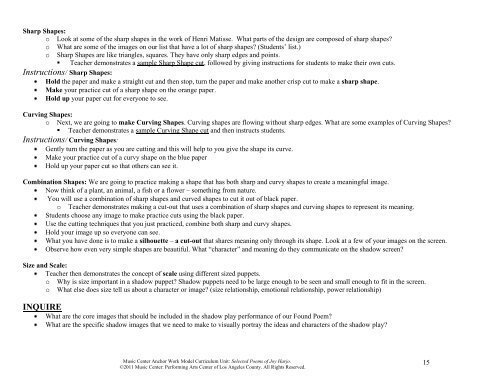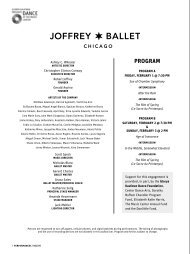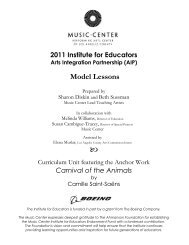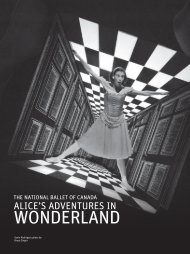Selected Poems of Joy Harjo - Music Center
Selected Poems of Joy Harjo - Music Center
Selected Poems of Joy Harjo - Music Center
Create successful ePaper yourself
Turn your PDF publications into a flip-book with our unique Google optimized e-Paper software.
Sharp Shapes:<br />
o Look at some <strong>of</strong> the sharp shapes in the work <strong>of</strong> Henri Matisse. What parts <strong>of</strong> the design are composed <strong>of</strong> sharp shapes?<br />
o What are some <strong>of</strong> the images on our list that have a lot <strong>of</strong> sharp shapes? (Students’ list.)<br />
o Sharp Shapes are like triangles, squares. They have only sharp edges and points.<br />
Teacher demonstrates a sample Sharp Shape cut, followed by giving instructions for students to make their own cuts.<br />
Instructions/ Sharp Shapes:<br />
Hold the paper and make a straight cut and then stop, turn the paper and make another crisp cut to make a sharp shape.<br />
Make your practice cut <strong>of</strong> a sharp shape on the orange paper.<br />
Hold up your paper cut for everyone to see.<br />
Curving Shapes:<br />
o Next, we are going to make Curving Shapes. Curving shapes are flowing without sharp edges. What are some examples <strong>of</strong> Curving Shapes?<br />
Teacher demonstrates a sample Curving Shape cut and then instructs students.<br />
Instructions/ Curving Shapes:<br />
Gently turn the paper as you are cutting and this will help to you give the shape its curve.<br />
Make your practice cut <strong>of</strong> a curvy shape on the blue paper<br />
Hold up your paper cut so that others can see it.<br />
Combination Shapes: We are going to practice making a shape that has both sharp and curvy shapes to create a meaningful image.<br />
Now think <strong>of</strong> a plant, an animal, a fish or a flower – something from nature.<br />
You will use a combination <strong>of</strong> sharp shapes and curved shapes to cut it out <strong>of</strong> black paper.<br />
o Teacher demonstrates making a cut-out that uses a combination <strong>of</strong> sharp shapes and curving shapes to represent its meaning.<br />
Students choose any image to make practice cuts using the black paper.<br />
Use the cutting techniques that you just practiced, combine both sharp and curvy shapes.<br />
Hold your image up so everyone can see.<br />
What you have done is to make a silhouette – a cut-out that shares meaning only through its shape. Look at a few <strong>of</strong> your images on the screen.<br />
Observe how even very simple shapes are beautiful. What “character” and meaning do they communicate on the shadow screen?<br />
Size and Scale:<br />
Teacher then demonstrates the concept <strong>of</strong> scale using different sized puppets.<br />
o Why is size important in a shadow puppet? Shadow puppets need to be large enough to be seen and small enough to fit in the screen.<br />
o What else does size tell us about a character or image? (size relationship, emotional relationship, power relationship)<br />
INQUIRE<br />
What are the core images that should be included in the shadow play performance <strong>of</strong> our Found Poem?<br />
What are the specific shadow images that we need to make to visually portray the ideas and characters <strong>of</strong> the shadow play?<br />
<strong>Music</strong> <strong>Center</strong> Anchor Work Model Curriculum Unit: <strong>Selected</strong> <strong>Poems</strong> <strong>of</strong> <strong>Joy</strong> <strong>Harjo</strong>.<br />
©2011 <strong>Music</strong> <strong>Center</strong>: Performing Arts <strong>Center</strong> <strong>of</strong> Los Angeles County. All Rights Reserved.<br />
15






